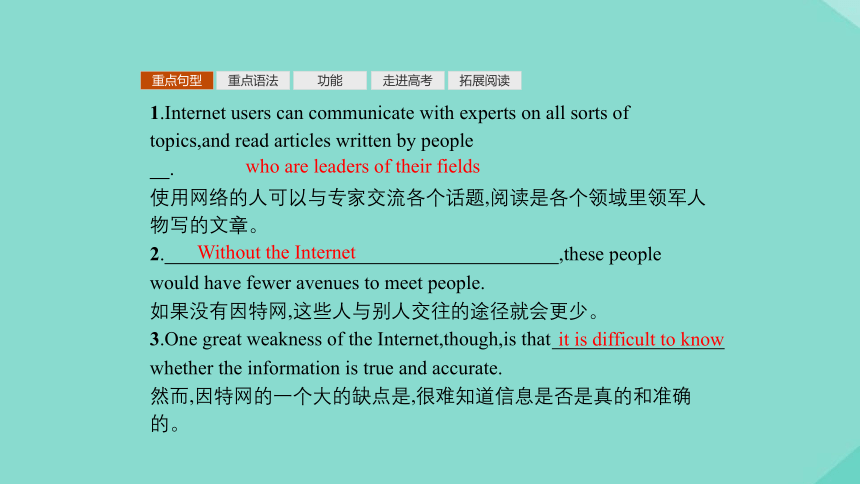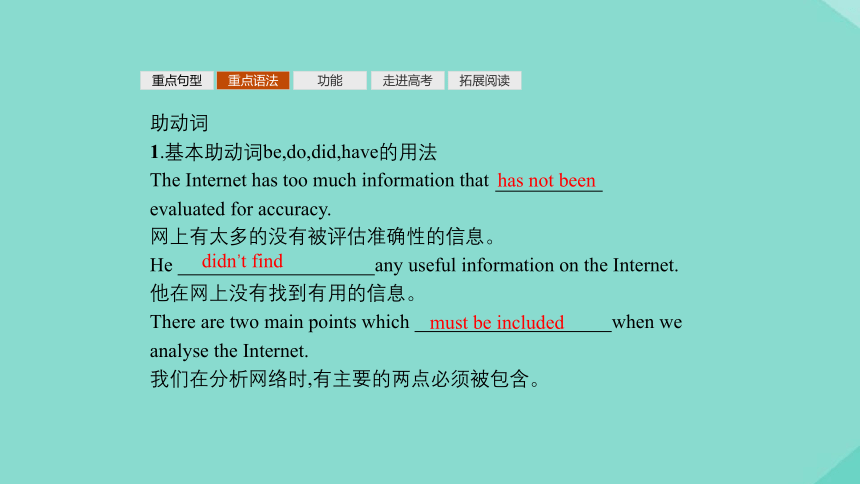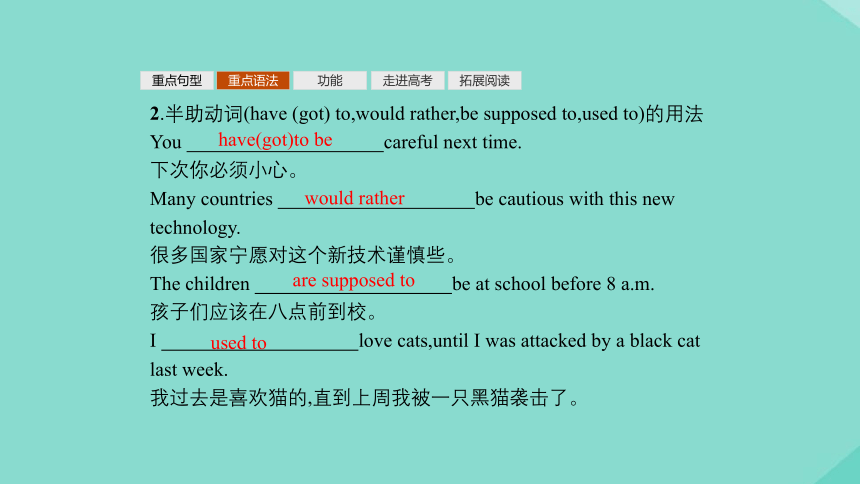2019_2020学年牛津译林版选修7 Unit3 The world online单元重点小结课件(16张ppt)
文档属性
| 名称 | 2019_2020学年牛津译林版选修7 Unit3 The world online单元重点小结课件(16张ppt) |  | |
| 格式 | zip | ||
| 文件大小 | 115.1KB | ||
| 资源类型 | 教案 | ||
| 版本资源 | 牛津译林版 | ||
| 科目 | 英语 | ||
| 更新时间 | 2019-08-25 19:00:52 | ||
图片预览







文档简介
(共16张PPT)
单元重点小结
重点句型
重点语法
功能
1.Internet users can communicate with experts on all sorts of topics,and read articles written by people .?
使用网络的人可以与专家交流各个话题,阅读是各个领域里领军人物写的文章。
2. ,these people would have fewer avenues to meet people.?
如果没有因特网,这些人与别人交往的途径就会更少。
3.One great weakness of the Internet,though,is that whether the information is true and accurate.?
然而,因特网的一个大的缺点是,很难知道信息是否是真的和准确的。
who are leaders of their fields
Without the Internet
it is difficult to know
走进高考
拓展阅读
重点句型
重点语法
功能
4. you know about Internet research,
you will find what you are looking for,and the better informed you will be.?
对于网络研究,你了解得越多,就能越快地找到要找的内容,获取的信息也会越好。
5. ,and your time spent doing research on the Internet will be much more worthwhile.?
遵循这些建议,你花在网上研究的时间就会越值得。
The more
the faster
Follow these tips
走进高考
拓展阅读
重点句型
重点语法
功能
助动词
1.基本助动词be,do,did,have的用法
The Internet has too much information that evaluated for accuracy.?
网上有太多的没有被评估准确性的信息。
He any useful information on the Internet.?
他在网上没有找到有用的信息。
There are two main points which when we analyse the Internet.?
我们在分析网络时,有主要的两点必须被包含。
has not been
didn’t find
must be included
走进高考
拓展阅读
重点句型
重点语法
功能
2.半助动词(have (got) to,would rather,be supposed to,used to)的用法
You careful next time.?
下次你必须小心。
Many countries be cautious with this new technology.?
很多国家宁愿对这个新技术谨慎些。
The children be at school before 8 a.m.?
孩子们应该在八点前到校。
I love cats,until I was attacked by a black cat last week.?
我过去是喜欢猫的,直到上周我被一只黑猫袭击了。
have(got)to be
would rather
are supposed to
used to
走进高考
拓展阅读
重点句型
重点语法
功能
Talking about one’s health and disease(谈论健康和疾病)
1.How are you feeling today?
你今天感觉怎么样?
2.I don’t feel very well this morning.
今天早上我感觉非常不好。
3.I was sick yesterday,but I’m better today.
昨天我病了,但是今天好点了。
4.My fever is gone,but I still have a cough.
我的烧退了,但我还有些咳嗽。
5.My brother has a bad headache.
我哥哥头疼得厉害。
6.Which of your arms is sore?
你的哪只胳膊疼?
走进高考
拓展阅读
重点句型
重点语法
功能
7.My right arm hurts.It hurts right here.
我的右胳膊受伤了。伤就在这里。
8.What’s the matter with you?
你怎么样了?
9.I’ve got a pain in my back.
我的背痛。
10.Which foot hurts?Is it the left one?
哪只脚受伤了?是左脚吗?
11.How did you break your leg?
你的腿怎么断的?
走进高考
拓展阅读
重点句型
重点语法
功能
12.I slipped on the stairs and fell down.I broke my leg.
我在楼梯上滑倒摔了下来,摔断了腿。
13.Your right hand is swollen.
你的右手肿了。
14.It’s bleeding.You’d better go see a doctor.
伤口出血了,你最好找医生看看。
15.I hope you’ll be well soon.
希望你快点好起来。
走进高考
拓展阅读
重点句型
重点语法
功能
走进高考
拓展阅读
主旨大意题解题技巧
一、题型特点
在高考英语阅读理解中,主旨大意题是必考的阅读题型之一。主旨大意题包括概括文章大意、给文章选择适合的标题、指出作者的写作目的等。命题方式常有以下类型:
1.概括文章中心思想或段落大意的题干。
What is the passage mainly about?
2.考查作者的写作目的和意图的题干。
The purpose of the passage is .?
What is the main purpose of the passage?
3.选择标题的题干。
Which of the following can be the best title of the passage?
Which of the following is the best title for the passage?
重点句型
重点语法
功能
走进高考
拓展阅读
二、解题步骤与技巧
1.做此类题目时,首先要搞清是问某一段还是全文的大意,可利用文中主要信息来把握文脉,进行综合归纳,概括文章的主题。如有标题,标题中蕴含的信息往往是关键信息。另外,任何一篇文章都是围绕某个主题展开的,因此,许多文章中最明显的特点之一是有一个反复出现的中心词,即高频词,也叫做主题词。抓住了它,便容易抓住文章的中心。
2.要学会借助文章的结构来把握中心思想。段落中心思想常常由主题句来表达。主题句常常出现在段首或段尾处,有时也在段落中间。同样,一篇文章的中心思想也常常在开始段或结尾段点出。因此,在阅读中,我们要对文章的开始段和结尾段及段落的主题句给予特别的注意。
重点句型
重点语法
功能
走进高考
拓展阅读
3.文章的标题是中心思想最精炼的表达形式,选择的标题意义范围要能涵盖全文,不能太大也不能太小。标题可以是单词、短语,也可以是句子。做这类题时,要把概括范围过窄或过宽的选项排除掉。
总而言之,主旨大意题是考生容易出错的题型之一,但只要我们掌握并运用行之有效的解题技巧,在理解文章内容的基础上仔细对比四个选项之间的差异,定能选出正确答案。
重点句型
重点语法
功能
走进高考
拓展阅读
Asia-Pacific consumers① are the world’s largest group of online shopping lovers and many rely on Internet reviews when making purchases,research firm Nielsen said this week.
The firm said 35% of consumers in Asia-Pacific used over 11% of their monthly spending to make online purchases,compared to a global average of 27% of consumers.
South Koreans were the heaviest online buyers in Asia,with 59% directing more than 11% of their monthly spending to online purchases,followed by 41% in China,Nielsen said in a report.
重点句型
重点语法
功能
走进高考
拓展阅读
A further 31% of Asian consumers use between 6% and 10% of their monthly shopping purchases to buy items online.
More Asia-Pacific consumers also intend to buy online in the next six months than those from other regions②,with South Koreans and Chinese the most likely to make such purchases.
Among the purchases consumers in the region are likely to make in the next six months are books,clothing,shoes,airline tickets,electronic equipment and hotel reservations.
Nielsen said opinions posted online were important in Asia-Pacific customers’ decisions to buy products such as cosmetics③,cars,software and food.
重点句型
重点语法
功能
走进高考
拓展阅读
Asia-Pacific consumers were also the most likely to share dissatisfaction at a product on the Internet compared with consumers elsewhere.
“The increasing accessibility of the Internet and unbelievable popularity of social media and online discussion forums④ mean today’s brands have nowhere to hide,” said Megan Clarken,Asia-Pacific managing director at Nielsen’s online division.
Nielsen said in June that social media such as Facebook and Twitter or blogging sites had become powerful tools influencing what people buy and urged businesses to embrace⑤ the trend.
重点句型
重点语法
功能
走进高考
拓展阅读
词海拾贝?
①consumer [k?n?sju?m?(r)] n.消费者
②region [?ri?d??n] n.地区
③cosmetics [k?z?metIks] n.化妆品
④forum [?f??r?m] n.论坛
⑤embrace [Im?breIs] v.拥抱
重点句型
重点语法
功能
走进高考
拓展阅读
理解诱思?
1.What influences Asia-Pacific consumers most when making purchases online?
A.Other buyers’ comments.
B.Powerful online tools.
C.The varieties of online item.
D.The price and the way to play.
答案A
2.Do you often buy items online?Why?
答案Yes,because it is convenient and sometimes very cheap.?
单元重点小结
重点句型
重点语法
功能
1.Internet users can communicate with experts on all sorts of topics,and read articles written by people .?
使用网络的人可以与专家交流各个话题,阅读是各个领域里领军人物写的文章。
2. ,these people would have fewer avenues to meet people.?
如果没有因特网,这些人与别人交往的途径就会更少。
3.One great weakness of the Internet,though,is that whether the information is true and accurate.?
然而,因特网的一个大的缺点是,很难知道信息是否是真的和准确的。
who are leaders of their fields
Without the Internet
it is difficult to know
走进高考
拓展阅读
重点句型
重点语法
功能
4. you know about Internet research,
you will find what you are looking for,and the better informed you will be.?
对于网络研究,你了解得越多,就能越快地找到要找的内容,获取的信息也会越好。
5. ,and your time spent doing research on the Internet will be much more worthwhile.?
遵循这些建议,你花在网上研究的时间就会越值得。
The more
the faster
Follow these tips
走进高考
拓展阅读
重点句型
重点语法
功能
助动词
1.基本助动词be,do,did,have的用法
The Internet has too much information that evaluated for accuracy.?
网上有太多的没有被评估准确性的信息。
He any useful information on the Internet.?
他在网上没有找到有用的信息。
There are two main points which when we analyse the Internet.?
我们在分析网络时,有主要的两点必须被包含。
has not been
didn’t find
must be included
走进高考
拓展阅读
重点句型
重点语法
功能
2.半助动词(have (got) to,would rather,be supposed to,used to)的用法
You careful next time.?
下次你必须小心。
Many countries be cautious with this new technology.?
很多国家宁愿对这个新技术谨慎些。
The children be at school before 8 a.m.?
孩子们应该在八点前到校。
I love cats,until I was attacked by a black cat last week.?
我过去是喜欢猫的,直到上周我被一只黑猫袭击了。
have(got)to be
would rather
are supposed to
used to
走进高考
拓展阅读
重点句型
重点语法
功能
Talking about one’s health and disease(谈论健康和疾病)
1.How are you feeling today?
你今天感觉怎么样?
2.I don’t feel very well this morning.
今天早上我感觉非常不好。
3.I was sick yesterday,but I’m better today.
昨天我病了,但是今天好点了。
4.My fever is gone,but I still have a cough.
我的烧退了,但我还有些咳嗽。
5.My brother has a bad headache.
我哥哥头疼得厉害。
6.Which of your arms is sore?
你的哪只胳膊疼?
走进高考
拓展阅读
重点句型
重点语法
功能
7.My right arm hurts.It hurts right here.
我的右胳膊受伤了。伤就在这里。
8.What’s the matter with you?
你怎么样了?
9.I’ve got a pain in my back.
我的背痛。
10.Which foot hurts?Is it the left one?
哪只脚受伤了?是左脚吗?
11.How did you break your leg?
你的腿怎么断的?
走进高考
拓展阅读
重点句型
重点语法
功能
12.I slipped on the stairs and fell down.I broke my leg.
我在楼梯上滑倒摔了下来,摔断了腿。
13.Your right hand is swollen.
你的右手肿了。
14.It’s bleeding.You’d better go see a doctor.
伤口出血了,你最好找医生看看。
15.I hope you’ll be well soon.
希望你快点好起来。
走进高考
拓展阅读
重点句型
重点语法
功能
走进高考
拓展阅读
主旨大意题解题技巧
一、题型特点
在高考英语阅读理解中,主旨大意题是必考的阅读题型之一。主旨大意题包括概括文章大意、给文章选择适合的标题、指出作者的写作目的等。命题方式常有以下类型:
1.概括文章中心思想或段落大意的题干。
What is the passage mainly about?
2.考查作者的写作目的和意图的题干。
The purpose of the passage is .?
What is the main purpose of the passage?
3.选择标题的题干。
Which of the following can be the best title of the passage?
Which of the following is the best title for the passage?
重点句型
重点语法
功能
走进高考
拓展阅读
二、解题步骤与技巧
1.做此类题目时,首先要搞清是问某一段还是全文的大意,可利用文中主要信息来把握文脉,进行综合归纳,概括文章的主题。如有标题,标题中蕴含的信息往往是关键信息。另外,任何一篇文章都是围绕某个主题展开的,因此,许多文章中最明显的特点之一是有一个反复出现的中心词,即高频词,也叫做主题词。抓住了它,便容易抓住文章的中心。
2.要学会借助文章的结构来把握中心思想。段落中心思想常常由主题句来表达。主题句常常出现在段首或段尾处,有时也在段落中间。同样,一篇文章的中心思想也常常在开始段或结尾段点出。因此,在阅读中,我们要对文章的开始段和结尾段及段落的主题句给予特别的注意。
重点句型
重点语法
功能
走进高考
拓展阅读
3.文章的标题是中心思想最精炼的表达形式,选择的标题意义范围要能涵盖全文,不能太大也不能太小。标题可以是单词、短语,也可以是句子。做这类题时,要把概括范围过窄或过宽的选项排除掉。
总而言之,主旨大意题是考生容易出错的题型之一,但只要我们掌握并运用行之有效的解题技巧,在理解文章内容的基础上仔细对比四个选项之间的差异,定能选出正确答案。
重点句型
重点语法
功能
走进高考
拓展阅读
Asia-Pacific consumers① are the world’s largest group of online shopping lovers and many rely on Internet reviews when making purchases,research firm Nielsen said this week.
The firm said 35% of consumers in Asia-Pacific used over 11% of their monthly spending to make online purchases,compared to a global average of 27% of consumers.
South Koreans were the heaviest online buyers in Asia,with 59% directing more than 11% of their monthly spending to online purchases,followed by 41% in China,Nielsen said in a report.
重点句型
重点语法
功能
走进高考
拓展阅读
A further 31% of Asian consumers use between 6% and 10% of their monthly shopping purchases to buy items online.
More Asia-Pacific consumers also intend to buy online in the next six months than those from other regions②,with South Koreans and Chinese the most likely to make such purchases.
Among the purchases consumers in the region are likely to make in the next six months are books,clothing,shoes,airline tickets,electronic equipment and hotel reservations.
Nielsen said opinions posted online were important in Asia-Pacific customers’ decisions to buy products such as cosmetics③,cars,software and food.
重点句型
重点语法
功能
走进高考
拓展阅读
Asia-Pacific consumers were also the most likely to share dissatisfaction at a product on the Internet compared with consumers elsewhere.
“The increasing accessibility of the Internet and unbelievable popularity of social media and online discussion forums④ mean today’s brands have nowhere to hide,” said Megan Clarken,Asia-Pacific managing director at Nielsen’s online division.
Nielsen said in June that social media such as Facebook and Twitter or blogging sites had become powerful tools influencing what people buy and urged businesses to embrace⑤ the trend.
重点句型
重点语法
功能
走进高考
拓展阅读
词海拾贝?
①consumer [k?n?sju?m?(r)] n.消费者
②region [?ri?d??n] n.地区
③cosmetics [k?z?metIks] n.化妆品
④forum [?f??r?m] n.论坛
⑤embrace [Im?breIs] v.拥抱
重点句型
重点语法
功能
走进高考
拓展阅读
理解诱思?
1.What influences Asia-Pacific consumers most when making purchases online?
A.Other buyers’ comments.
B.Powerful online tools.
C.The varieties of online item.
D.The price and the way to play.
答案A
2.Do you often buy items online?Why?
答案Yes,because it is convenient and sometimes very cheap.?
